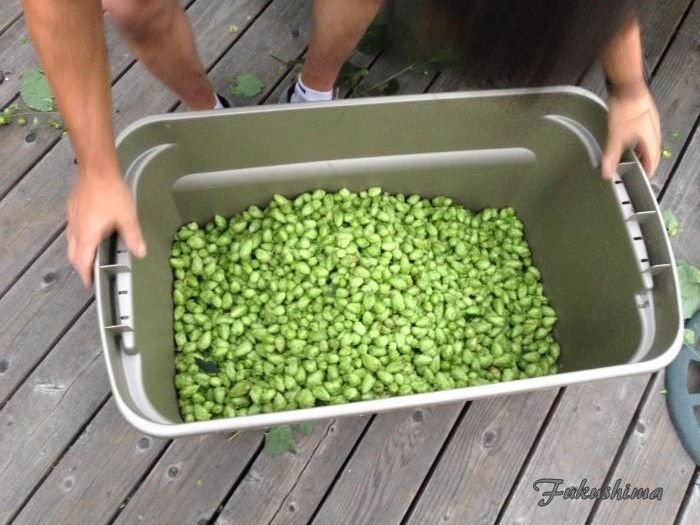Hop Bines
So, that shows the bines, prior to harvest. A note, I know how to spell. Hops grow on bines, technically, a bine is a plant that climbs by entwining a support structure, as opposed to using aerial roots or tendrils. The bines in the above image, are on a 25 foot tall supports structure, with an ingenious pulley system, that not only allows harvest of the hops, but, allows for growth exceeding 25 feet. As the bines reach the 25 foot mark, Saul lowers the ropes through the pulley, giving him more room. These bines were actually closer to the 35 foot mark.
Hop Clusters
Here are the hops still on the plant, the actual hop that we are interested in, is a flower, that grows in clusters, hanging from the terminal of the branches of the bine. The hops appear as cones, and are often mislabelled as flowers, In truth, they are strobiles, cone structures that house the reproduction for the plant. The resin, which is what makes hops so valuable to brewers, is a yellow powder that is located along the central core of the hop. These are actually quite beautiful structures as they hang amongst the dark green leaves.
Hop Strobile/Flower/Cone
Just a glamour shot of a large and quite lovely hop strobile. This is something you never see at a brew shop, the large, fresh, hydrated version of the little green pellets or smashed up petals in a vacuum pack. These are far less delicate than they look, but, so valuable to a brewer, you want to take a little extra care when handling them anyway. I also found out, that the billions of tiny hair like thorns on the bines, which I blithely ignored (after all, I am the son of a rose grower) actually scratched up my arms so much, it took two days for the feeling of burning to calm down. Next time, long sleeves.
Tub o' Hops
And the end result, this is actually around 2/3rds of what was on the plants. Saul estimated that this would make about 5 batches of ale. These will be air dried and then Saul vacuum packs them for use throughout the year. I ended up with about 15 ounces to take home, which will end up as around 3 ounces of hops once dried. I will be brewing a Saul ale at that time. What a great time I had, both with the fact that I got to experience the harvest of an integral part of one of my hobbies, and for the fact that I was able to catch up again with my friend Saul and his lovely wife Carla, whom I also went to high school with. There are not a lot of better ways to spend an afternoon.





Very nice and informative. The scent of fresh hops is wonderful.
ReplyDelete-Odin